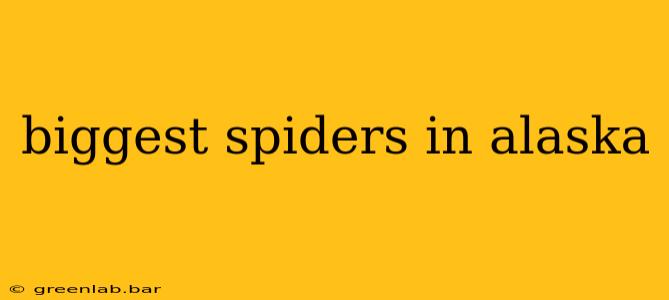Alaska, the land of majestic glaciers, towering mountains, and abundant wildlife, might not immediately spring to mind when discussing giant spiders. While the state's reputation leans towards larger mammals and breathtaking landscapes, it does harbor a surprising variety of arachnids, some of which reach impressive sizes for their northerly habitat. This article delves into the largest spiders found in Alaska, dispelling common misconceptions and exploring their unique adaptations to the harsh Alaskan environment.
Debunking the Myths: Are There Really Giant Spiders in Alaska?
The internet is rife with exaggerated claims about monstrous spiders inhabiting Alaska. While the reality is far less dramatic than some sensationalized accounts, several spider species in the state can indeed grow quite large compared to their counterparts in other regions. It's crucial to understand that "giant" is relative; we're not talking about spiders the size of dinner plates. However, some Alaskan spiders can have leg spans exceeding several inches, which can be quite startling for those unfamiliar with the region's arachnid fauna.
The Contenders for Alaska's Largest Spiders:
Pinpointing the absolute "biggest" spider in Alaska is challenging due to variations in individual size and limited comprehensive surveys across the vast Alaskan wilderness. However, several species consistently stand out for their notable size:
1. Giant Crab Spiders (Genus Misumena):
While not exceptionally large in terms of body mass, certain species of giant crab spiders found in Alaska boast impressively long leg spans. These spiders are ambush predators, using their camouflage skills to blend in with flowers and foliage, waiting patiently to snatch unsuspecting prey. Their size can vary based on food availability, with females generally larger than males.
2. Wolf Spiders (Family Lycosidae):
Alaska's wolf spiders are known for their impressive size and hairy bodies. These hunting spiders are active predators, relying on their speed and agility to capture their prey. Several species within this family can achieve a significant leg span, making them contenders for the title of Alaska's largest spiders in many areas.
3. Orb-Weaving Spiders (Family Araneidae):
While not all orb-weavers are giants, some species in Alaska build remarkably large webs, suggesting the spiders themselves can reach significant sizes. These spiders typically construct intricate webs to trap flying insects. The size of the orb-weaver depends heavily on the species and the abundance of food.
Factors Affecting Spider Size in Alaska:
Several environmental factors influence the size of Alaskan spiders:
- Food Availability: A plentiful supply of insects and other prey is crucial for spider growth. Areas with abundant insect populations are likely to harbor larger spiders.
- Climate: Alaska's varied climate plays a role; warmer, more temperate regions might support larger spiders than those in colder, harsher environments.
- Species-Specific Variations: Different spider species have inherent size limitations dictated by their genetics and evolutionary adaptations.
Are Alaskan Giant Spiders Dangerous?
While the prospect of large spiders might seem intimidating, the vast majority of Alaskan spiders pose minimal threat to humans. Their venom is generally not considered medically significant, causing at most mild localized reactions in sensitive individuals. It's always best to admire these creatures from a safe distance and avoid handling them unnecessarily.
Conclusion:
Alaska's largest spiders, while not reaching monstrous proportions, can still be quite impressive in size. Understanding the species inhabiting the state, the factors influencing their size, and their relatively harmless nature contributes to a more nuanced and informed appreciation of Alaska's diverse wildlife. Remember always to approach wildlife with respect and caution, enjoying their presence from a safe distance.

